Types of Spruce Trees and Shrubs With Identification Guide (Pictures & Name)
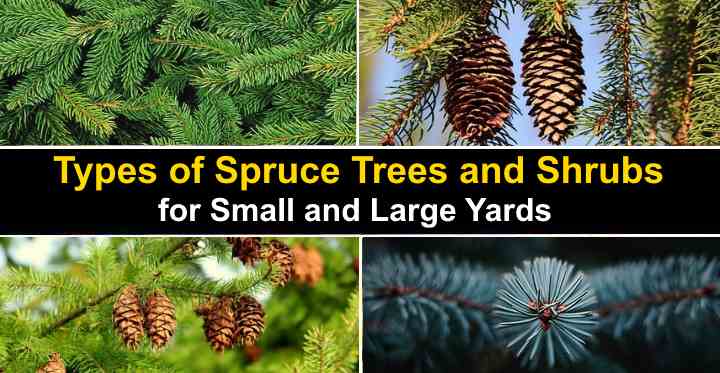
Spruce trees are species of evergreen conifers that have sharp needle leaves. Apart from tall spruce trees that grow in coniferous forests, many dwarf spruces and spruce shrubs are suitable for garden landscapes.
There are 35 species of spruce trees belonging to the genus Picea. These evergreen trees are related to other coniferous trees, such as pine, cedar, fir, and hemlock trees.
Common types of spruce trees: The most well-known spruce tree is the Norwegian spruce, which is a popular Christmas tree. Other common spruce trees for gardens are the Alberta spruce, White spruce, and Engelmann’s Spruce. The Bird’s Nest Spruce is a dwarf, low-growing landscaping shrub for front or backyards.
Spruce trees are some of the tallest conifers that grow in evergreen forests. For example, the Sitka spruce (Picea sitchensis) can reach the dizzy heights of more than 330 ft. (100 m) tall. For your garden—large or small—dwarf spruce trees and low shrubs are ideal for growing as specimen trees or as an evergreen hedge.
In their native habitat—the cold and temperate regions of the Northern Hemisphere—spruces live for over 200 years. If you plant spruce shrubs or dwarf spruce trees in your backyard, you can expect them to grow for up to 60 years.
Generally, most spruce trees have a slow growth habit and average between 6” and 11” (15 – 29 cm) per year. Other species of spruce—notably the Norway spruce (Picea abies) and Sitka spruce (Picea sitchensis) grow at a much faster rate. Some of these spruce species grow around 3 ft. (1 m) per year.
All species of coniferous trees are in the softwood tree classification. Spruce trees produce a relatively soft type of wood, similar to soft pine. However, compared to pine timber, spruce wood is a higher quality and more durable than most pine wood.
In this article, you will learn about the most popular types of spruce trees. Along with descriptions, pictures of spruces and their scientific names will help you identify the most common spruce trees.
Spruce Tree Identification

Picture of spruce needles. Spruce needles grow singularly on the branch (unlike pine needles which grow in clusters) and are round (unlike fir needles which are flat)
Spruce trees can be identified by their needles which have four sides. Each needle is individually attached to the branch and can be rolled easily between your fingers. Another way to identify spruce trees is by their cones that are covered with smooth thin scales. It is quite easy to bend the cones of spruce trees. Spruce trees have bushy branches that point up.
Spruce Trees Vs. Pine Trees Vs. Fir Trees
Unlike fir tree needles, which are flat, Spruce needles are square and roll easily. Spruce needles are short and stiff, whereas pine trees have needles that are long and soft.
Pine needles grow on branches in small bunches from two to seven. However spruce trees have individual needles growing on the branches.
You can also tell spruce trees apart from pine trees by looking at their shape. Spruce tree branches tend to have an upward growth with full, bushy needle foliage. On the other hand, pine trees branches have a downward growth habit and less dense foliage.
Cedar trees and Douglas firs are soft to touch, unlike jaggy, sharp spruce needle-leaves.
Related: Ultimate Conifer Identification Guide: Pine, Fir, and Spruce with Pictures, Charts, and Names
Types of Spruce Trees (With Pictures and Names)
Let’s look in more detail at how to identify the many types of majestic spruce trees.
Norway Spruce (Picea abies)
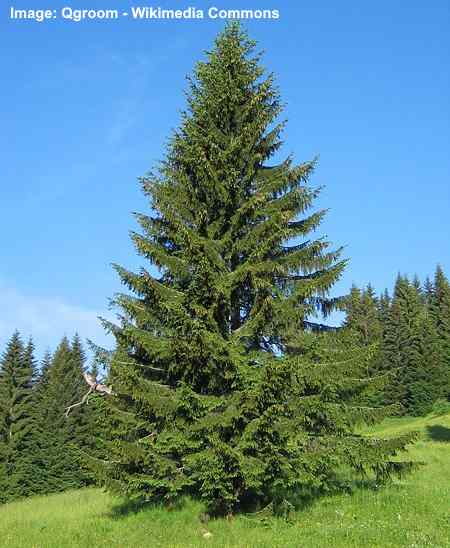
The Norway spruce is a fast growing cold hardy evergreen tree
Also called the European spruce, the Norway spruce tree is a fast-growing evergreen tree that grows in many coniferous forests. The wood from Norway spruce is high quality and excellent for timber, pulp, and producing musical instruments. The dense foliage of these spruce trees makes them ideal for living privacy screens, windbreaks, or hedges.
Spruce tree identification
You can identify Norway spruce tree by its pyramidal shape and upward growing branches. The short green needle leaves have blunt tips. Its seed cones are long and oblong-shaped. Norway spruces grow to between 115 and 180 ft. (35 – 55 m) tall. However, dwarf and weeping spruce cultivars only reach a few feet.
White Spruce (Picea glauca)
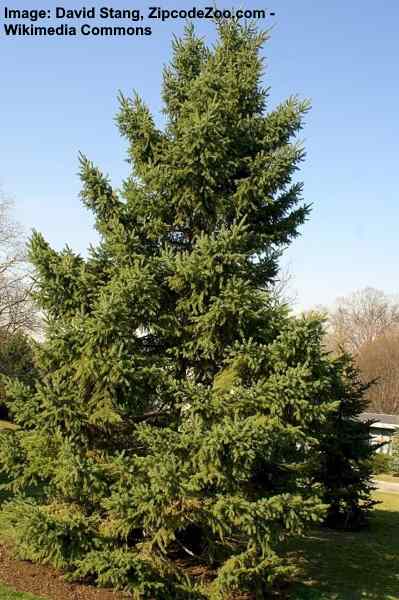
White spruce is extensively used in the timber industry
White spruce trees are native to North America and thrive in the freezing conditions of Alaskan and Canadian winters. Also called the Alberta White spruce, this coniferous species is an essential part of the timber industry, and its wood is used extensively in construction. The Picea glauca var. albertiana ‘Conica’ is a dwarf variety of this majestic spruce tree.
Spruce tree identification
You can identify white spruce trees by their scaly white bark, narrow cylindrical crown, and long needle-like leaves. Compared to the Norway spruce, the cones of this species are slender, but not as long. White spruce trees grow to about 100 ft. (30 m) tall.
Colorado Blue Spruce (Picea pungens)
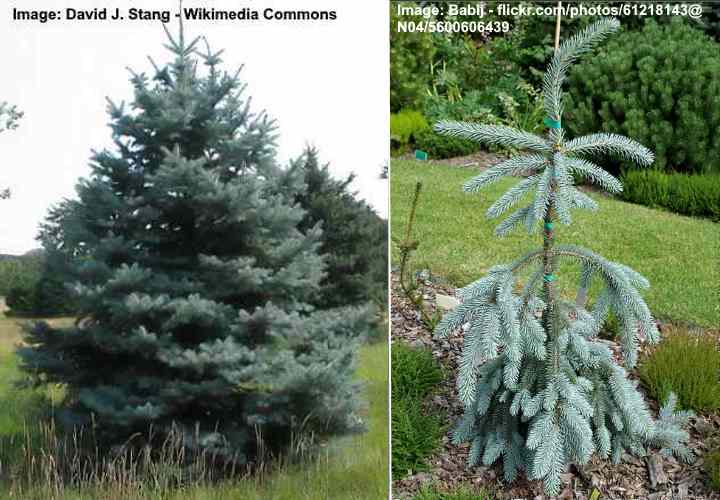
The blue spruce (left) makes a unique Christmas tree due to its blue-green-gray colored needles. On the right: Weeping Colorado spruce ‘The Blues’ is a dwarf evergreen cold hardy tree
The blue spruce conifer is the state tree of Colorado, and it thrives in USDA zones 1 to 7. This species of spruce grows extensively throughout North America. Colorado blue spruce trees are prized for their ornamental value and pyramidal shape. When looking at pictures of this spruce, it’s easy to see how it gets its name—its foliage has a distinct blue tinge to it.
If you’re looking for a weeping spruce tree for small to large gardens, the weeping Colorado spruce cultivar ‘The Blues’ is an excellent choice.
Spruce tree identification
Identification of the Colorado blue spruce is by its waxy bluish-green needle-like leaves. The botanical name—“pungens”—means “sharply pointed,” which refers to the short spiky needles. Colorado blue spruces grow up to 75 ft. (23 m) in forests and up to 50 ft. (15 m) in garden landscapes.
Serbian Spruce (Picea omorika)
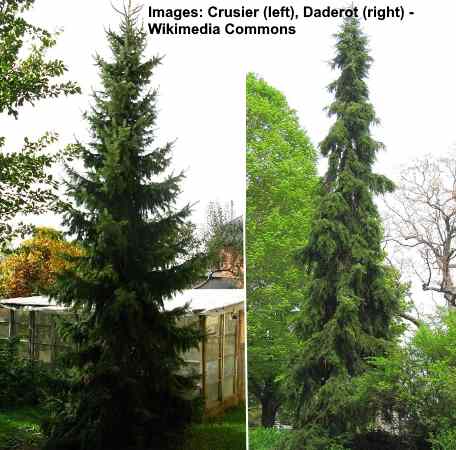
Left image: Serbian spruce. Right image: Weeping Serbian spruce Picea omorika ‘Pendula’
The Serbian spruce grows well in many conditions and can survive some drought and shade. The tall, slender nature of this tree makes it popular as a specimen tree in extensive gardens or parks. Compared to tall spruces such as the Norway and Sitka spruces, the Serbian species only reaches medium height.
For your garden landscape, look for the dwarf tree Picea omorika ‘Nana’ or the weeping spruce, Picea omorika ‘Pendula.’
Spruce tree identification
It is easy to identify Serbian spruce trees by its columnar growth habit. The medium-sized tree grows to around 65 ft. (20 m) tall and has a pencil-like shape. Small, dark-green needle leaves create lush-looking foliage along with short, spindle-shaped cones.
Black Spruce (Picea mariana)
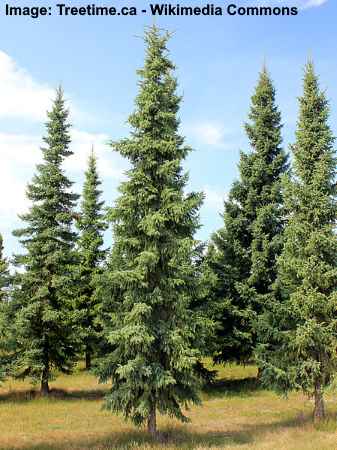
Black spruce is a slow-growing, small evergreen coniferous tree
The black spruce is a small conifer tree in the family Pinacaea that sometimes grows like a shrub. This slow-growing spruce is not of any importance in the timber industry as its wood is soft and of poor quality. The spruce tree commonly grows in damp, swampy areas in Canada, Alaska, and the upper Northeast of the US.
Spruce tree identification
An identifying feature of the black spruce is its small, stumpy purple cones. Its needle leaves are square are about half an inch (1.5 cm) long. As a small conifer, this species grows to between 15 and 50 ft. (5 – 15 m) tall. A grayish-brown, thin scaly bark covers the trunk.
Engelmann’s Spruce (Picea engelmannii)
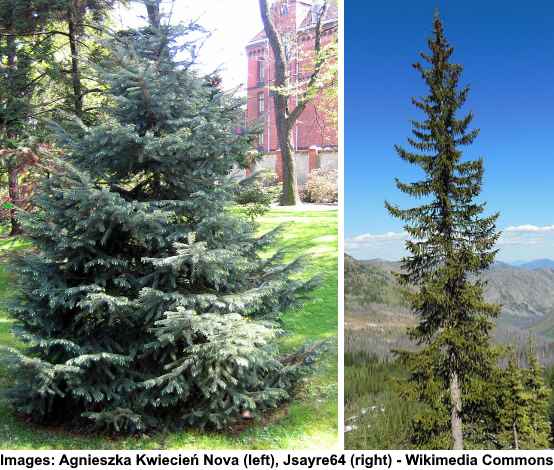
Left picture: A young Engelmann’s spruce. Right picture: A mature tree
Engelmann’s Spruce tree is a species of spruce that gets its name from the botanist George Engelmann. This slender, conical tree grows at high altitudes on the northeast coast of North America. The dense wood from this slow-growing evergreen conifer is excellent for timber and making musical instruments. As an immature tree, its pyramid shape makes it ideal as a Christmas tree.
Spruce tree identification
You can identify these medium-sized spruce trees by their cylindrical, narrow shape. Engelmann spruces grow to an average of 100 ft. (30 m) tall. The foliage is glaucous bluish-green needles, and pendulous small conical brown cones appear in the dense spruce growth. The needle leaves grow up to 1.1” (3 cm) long.
Sitka Spruce (Picea sitchensis)
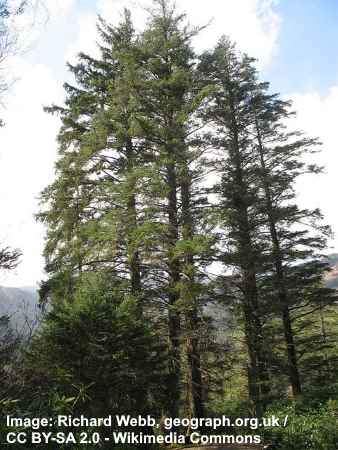
Sitka Spruce (Picea sitchensis) is one of the tallest types of conifer trees
The Sitka spruce is the largest spruce tree among the other 35 species in the genus Picea. This spruce species is also the fifth-largest species of conifer. The massive evergreen has a large, broad crown and few branches lower than 100 ft. (30 m). These fast-growing conifers thrive in poor soil and are prized for their timber.
Spruce tree identification
Apart from their enormous height, you can identify Sitka spruce trees by their sharp needle-like leaves that are about 1” (2.5 cm) long. The foliage has a blue-green appearance. Slender cones about 4” (10 cm) long dangling from the branches also help identify the spruce. The bark on the long, straight trunk is scaly and flakes off easily.
Red Spruce (Picea rubens)
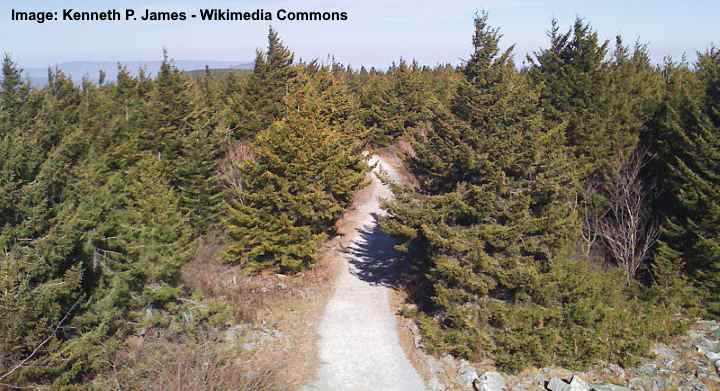
Red spruce forest (view from the top of the observation tower on Spruce Knob, West Virginia).
Also named the West Virginia spruce or the yellow spruce, this species grows in high altitudes on the eastern coast of North America. The spruce has moderate growth and can live for over 200 years in its native habitat. The perfect pyramid shape of the small red spruce makes the conifer ideal as a Christmas tree. Its yellow wood is used in construction and in making musical instruments
Spruce tree identification
Pictures of this spruce tree show dense foliage and small brown cones. The yellowish-green needles are curved and sharp. The identification of the West Virginia spruce is by its gray-brown bark that is red on the inside. The red spruce is a medium-sized tree, growing between 60 and 130 ft. (18 – 40 m) tall.
Caucasian Spruce (Picea orientalis)

In these pictures: Caucasian spruce trees (left), and small cultivars ‘Barnes’ (center) and ‘Nana’ (right)
The Oriental or Caucasian spruce is an ornamental tree with attractive light-green needle leaves. This slow-growing tree is a popular tree used as lumber and in paper production. Some cultivars, such as the Picea orientalis ‘Aureospicata,’ have stunning gold-colored foliage. To use the spruce in landscape gardens, look for varieties called ‘Barnes’ or ‘Nana.’
Spruce tree identification
Caucasian spruce identification is by its short needles—only measuring 0.3” (8 mm) long. The long slender cones add red and purple colors to the emerald-green foliage in the spring. The species of Caucasian spruce grows to between 100 and 145 ft. (30 – 45 m) tall.
Types of Spruce Shrubs and Dwarf Spruces
Many species of spruce trees are massive, tall trees that are generally not suitable for planting in backyards or landscape gardens.
If you want to enhance the beauty of your property with evergreen conifers, choose a dwarf spruce tree or shrubby spruce. Some small spruce trees have a shrub-like appearance that you can prune to control their height.
Let’s look at some excellent small spruce specimens.
Bird’s Nest Spruce (Picea abies ‘Nidiformis’)
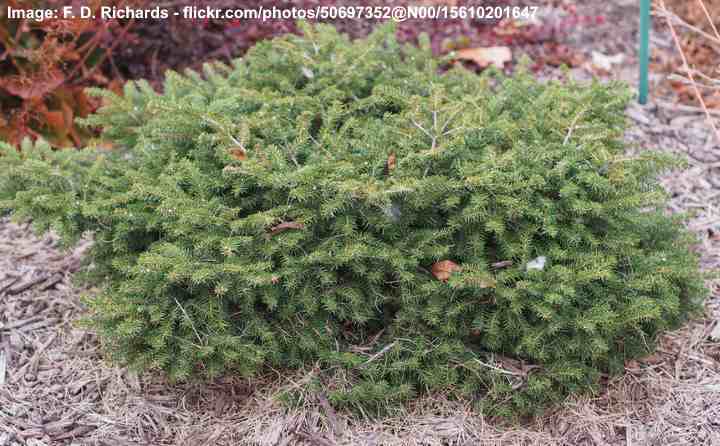
The birds nest spruce is a slow grower shrub with round shape and flat top
The bird’s nest spruce is a small shrub that is suitable for growing in containers or small gardens. As its scientific name suggests, this is a Norway spruce cultivar. However, it doesn’t grow into a tree but stays as a small bush. It is only a fraction of the size of its larger cousin. Its common name comes from the rounded, bushy growth that has an indentation in the middle—just like a bird’s nest.
Plant in rock gardens, as a specimen plant or short evergreen hedge.
Spruce tree identification
Its round shape and flat top identify this low-growing spruce shrub. The shrubby bush has blunt needles that grow to around an inch (2.5 cm) long. The shrub only grows to between 2 and 4 ft. (0.6 – 1.2 m) tall—and that is after many years.
Weeping Norway Spruce (Picea abies ‘Pendula’)
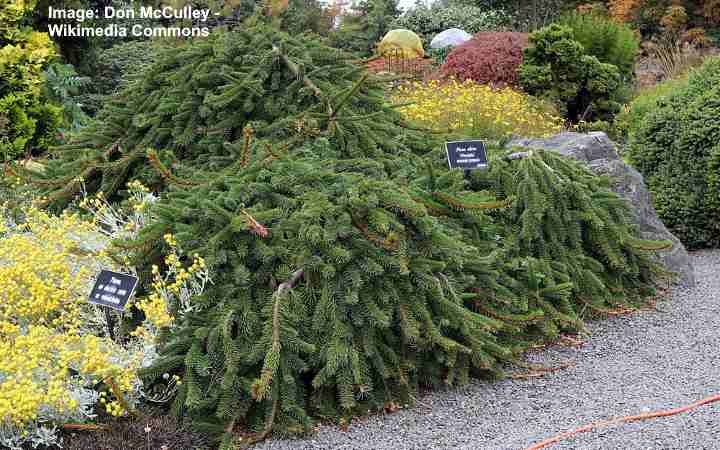
The weeping Norway spruce is an evergreen short tree suitable for cold areas
The weeping Norway spruce is an elegant spruce tree with drooping branches. Its branches are pendulous and bear extremely long cones—up to 9” (22 cm) long. The main stem needs support, and then the branches will dangle down until they eventually reach the ground. You can also grow this species of spruce as a plant for groundcover in full sun.
Spruce tree identification
Pendulous branches and spiky green foliage identify this species of weeping tree. With the proper care, the weeping Norway spruce can grow to between 10 and 15 ft. (3 – 4.5 m) tall.
Dwarf Norway Spruce (Picea abies ‘Pumila’)

Dwarf Norway spruce is a great choice for smaller garden landscape
The dwarf Norway spruce ‘Pumila’ is more of a low-growing shrub than a small evergreen tree. The dense foliage creates a stunning evergreen bush with a flat top. These slow-growing specimen plants are excellent for sunny borders, and they grow in most soils. This spruce’s most attractive features are its compact growth and bright-green foliage.
Spruce tree identification
The dwarf Norway shrub has foliage similar to the Norway spruce. This miniature cultivar only grows a maximum of 4 ft. (1.2 m). However, because its growth rate is about 5” (12 cm) per year, it will take a few years to reach maturity.
Dwarf Norway Spruce (Picea abies ‘Conica’)

Choose dwarf Norway spruce ‘Conica’ for compact spaces
One of the most popular dwarf conifers is the dwarf Norway spruce ‘Conica.’ The pyramidal-shaped tree has luscious green foliage made up of green needles. The upright tree growth, bushy foliage, and conical shape make the dwarf Norway spruce excellent as a hedging plant, specimen tree, or foundation planting.
Spruce tree identification
Dwarf Norway spruce can be identified by its densely packed, bright green foliage and conical shape. The little spruce tree is slow-growing type of spruce.
Dwarf Alberta Spruce (Picea glauca ‘Conica’)
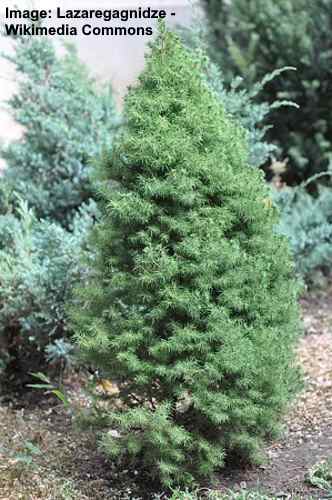
The dwarf Alberta spruce (also called dwarf white spruce) is an evergreen conifer tree that is slow growing. It reaches 10-12 ft. (3-4 m) and has conical shape with time. The foliage is dense with green needles and looks great as a privacy tree, hedging plant or specimen tree. It is very hardy evergreen tree that grows well in areas with cold winters with cool summers.
Spruce tree identification
The dwarf Alberta spruce has green needles, 3/4″ (7.5 cm) length, with sharp tips. The needles produce aromatic scent when crushed. The cones are rarely produced. They are cylindrical pale brown and are 2.5″ (6 cm) long with flexible scales.
White Spruce Shrub (Picea glauca ‘Echiniformis’)

The dwarf white spruce is a low growing shrub with slow growth rate
This white spruce cultivar is a slow-growing shrub that won’t grow higher than 1.5 ft. (0.5 m) in 10 years. The bush has a rounded growth habit that is formed by short spiky branches. This dwarf spruce is a perfect choice of evergreen if you are looking for a container shrub, border plant, or rock garden evergreen. Grow in full sun, and the plant thrives in USDA zone 2 to 7.
Spruce tree identification
Short, slender silver-green needles identify this low-growing shrub. Its growth rate is only 1” (2.5 cm) per year. This spruce shrub is easily recognizable by its oval, cushion-like shape and compact nature.
Dwarf Blue Spruce (Picea pungens ‘Globosa’)
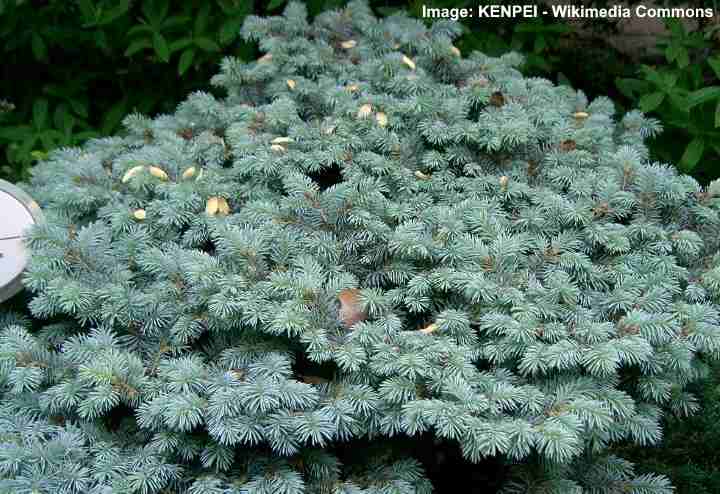
The dwarf blue spruce has ornamental silvery-blue foliage that adds decorative element to any garden
The most common dwarf Colorado blue spruce cultivar is the ‘Globosa.’ Its silvery-blue foliage makes this small shrub-like tree stand out in any garden landscape. Like most species of dwarf or shrub spruces, this is a low-maintenance plant that requires little attention. The spruce shrub is cold hardy to -40°F (-40°C) and enjoys full sun.
Spruce tree identification
The coarse blue-gray needles and stunted growth help identify the dwarf blue spruce. After ten years, it reaches a maximum of between 3 and 6 ft. (1 – 2 m).
Montgomery Colorado Blue Spruce Shrub (Picea pungens’ Montgomery’)
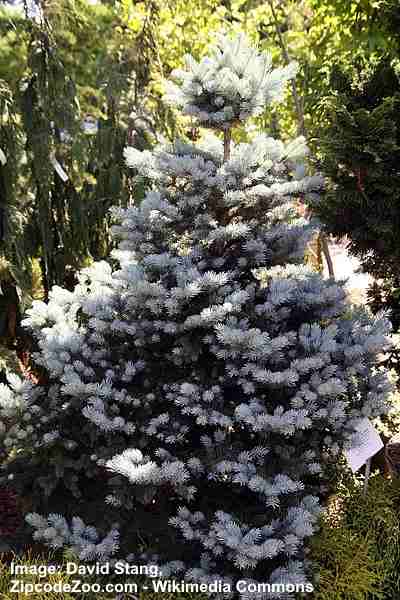
Montgomery Colorado Blue Spruce shrub has compact growth and beautiful silvery-gray foliage
The ‘Montgomery’ cultivar is another popular spruce shrub that is a fraction of the size of its larger cousin—the Colorado blue spruce. This dwarf shrub is prized for its pyramidal, mounding shape with dense, compact branches. Like all species of blue spruce, this specimen has blue-gray foliage that stands out in any front or backyard. Although similar to the ‘Globosa,’ the ‘Montgomery’ dwarf has a conical, rather than rounded shape.
Spruce tree identification
You can identify this spruce by its silvery-gray foliage on this small pyramid-shaped dwarf tree. At maturity, the little shrub-like spruce tree will be 4.5 ft. (1.5 m) and up to 3 ft. (1 m) wide at its base. The maximum annual growth rate is up to 6” (15 cm).
Related articles:
